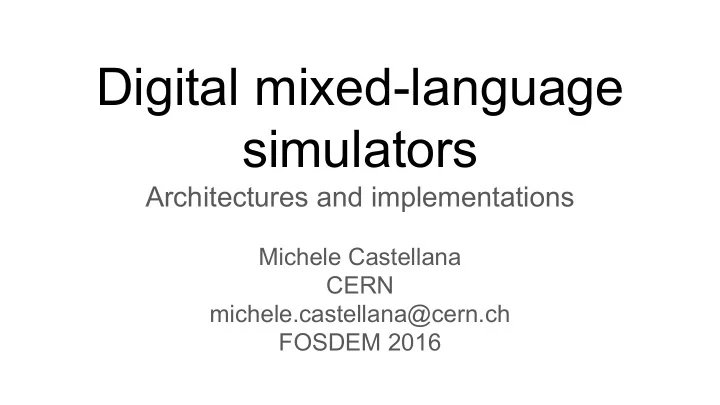

Digital mixed-language simulators Architectures and implementations Michele Castellana CERN michele.castellana@cern.ch FOSDEM 2016
Digital mixed-language simulator ● What is a simulator? ● Event based ● Why a mixed language simulator?
Compiler: Overview Architecture Front End Analysis Middle End Optimization Back End Code generation
Intermediate Representation ● Aid the analysis ● Different levels of abstraction ○ Example: AST and RTL ● Structure depends on the abstraction Original code High-level IR Mid-level IR Low-level IR int a[10][20]; t1 = a[i, j+2] t1 = j + 2 r1 = [fp - 4] a[i][j+2]; t2 = i * 20 r2 = [r1 + 2] t3 = t1 + t2 r3 = [fp - 8] t4 = 4 * t3 r4 = r3 * 20 t5 = addr a r5 = r4 + r2 t6 = t5 + t4 r6 = 4 * r5 t7 = *t6 r7 = fp – 216 f1 = [r7 + r6]
HDL compiler Three logical parts: ● Analysis ● Elaboration ● Simulation
Analysis Analyzer Design IR files ➢ Preprocessing ➢ Parse
Elaboration Elaborator IR Simulation Model ➢ Bind
Simulation ● Different possibilities ○ Runtime library ○ Virtual Machine ○ Produce code compliant with a simulation library
Digital Mixed-language simulator Two main proposed ideas
Independent compilers architecture icarus icarus vvp IR1 SM1 analyzer elaborator simulator Manager GHDL GHDL IR2 SM2 executable analyzer elaborator
Pros & cons Pros ● Code reusability ● Short-term results Cons ● Different IRs and elaborator ● Long-term features deal with synchronization ● Maintainability ● Worst case scenario
Savant architecture verilog analyzer Manager IR Elaborator SM Simulator VHDL analyzer
Pros & cons Pros ● Long-term results ○ No worst case scenario ○ Unique IR and elaborator ○ Maintainability Cons ● Code reusability ● Short-term results
Thank you! Questions?
References ● GHDL ● Icarus Verilog ● Savant project
Recommend
More recommend